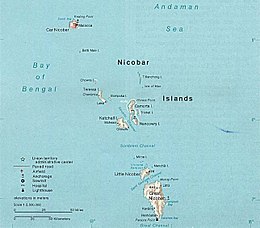Nicobarese languages
The Nicobarese languages (also Nicobarese languages ) are the native languages of the Nicobar Islands .
classification
The Nicobarese languages form a small genetic sub-unit of the Mon Khmer languages , which are one of the two main branches of Austro-Asian . This shows that the Nicobarese languages do not belong to the oldest language class in South Asia, e.g. B. the Andaman languages . Ethnically, the Nicobarese are much closer to the Mon Khmer peoples of the mainland than to the geographically neighboring Andameses.
The seven Nicobarese languages (between six and ten according to other classifications) are spoken by around 28,000 people as their mother tongue. The most important Nicobarese language is Car , which is used as a lingua franca throughout the archipelago. Contrary to previous studies, the language of the Shompen (around 400 speakers in the hinterland of Great Nicobar ) also belongs to the Nicobarese group, although it is the greatest distance from all other languages (van Driem 2008).
classification
The Nicobarese languages are classified as follows:
-
Nicobarese (28,000 native speakers in total)
-
Core Nicobarese
-
North
- Car (Pu) (20,000, with second speakers 37,000, lingua franca on the Nicobar Islands )
- Chowra (Chaura, Tutet, Tetet, Sanenyö) (2,000)
- Teressa (2,000) dialects: Teressa, Bompoka ( possibly Bompoka is a separate language )
-
Central
- Central Nicobarese (2,000) dialects: Nancowry, Camorta, Trinket, Katchall
-
south
- Greater Nicobarese (Lo'ong, Takahanyilang) ( low number of speakers )
- Little Nicobarese (Lamongse) (2,000) Dialects: Little Nicobar: Ong, Condul: Lamongse, Milo: Pihouny
-
North
-
Shompen
- Shompen (Shom Pen, Shom Peng, Shompeng, Sho-Bäng) (400)
-
Core Nicobarese
The number of speakers given in Ethnologue 2009 (see web link) is completely excessive and contradicting itself. In total there are 110,000 speakers of Nicobarese languages, while the total population of the Nicobarians according to the 2001 census does not exceed 43,000, of which only 28,000 are Nicobarese. The numbers of speakers given here (according to van Driem 2001) add up to the 2001 census value.
The Nicobar Islands suffered extremely as a result of the tsunami of December 26, 2004 , as they are close to the epicenter of the triggering seaquake. Officially, 4,405 dead and missing are reported, according to unofficial estimates up to a third of the Nicobarese fell victim to the tsunami. One can therefore assume that the stated number of speakers - which were recorded before the tsunami - must be corrected significantly downwards (cf. Singh 2006).
literature
- Paul K. Benedict: Austro-Thai Language and Culture. HRAF Press, New Haven CT 1975, ISBN 0-87536-323-7 .
- Robert Parkin: A Guide to Austroasiatic Speakers and Their Languages (= Oceanic Linguistics Special Publication. Vol. 23). University of Hawaii Press, Honolulu HI 1991, ISBN 0-8248-1377-4 .
- Simron Jit Singh: The Nicobar Islands. Cultural Choices in the Aftermath of the Tsunami. = The Nicobar Islands. The post-tsunami cultural heritage. Czernin, Vienna 2006, ISBN 3-7076-0078-5 (bilingual German and English).
- George van Driem: Languages of the Himalayas. An ethnolinguistic Handbook of the greater Himalayan Region. Containing an Introduction to the symbiotic Theory of Language (= Handbuch der Orientalistik. Dept. 2: India. = India. Vol. 10). Volume 1. Brill, Leiden et al. 2001, ISBN 90-04-12062-9 (Zum Nicobaresischen pp. 280-289).
- George van Driem: The Shompen of Great Nicobar Island: new linguistic and genetic data, and the Austroasiatic homeland. In: Mother Tongue . Vol. 13, 2008, pp. 227-247.
Web links
- Ethnologue, Classification of Nicobar Languages. (the specified number of speakers is completely excessive and contradicting)

